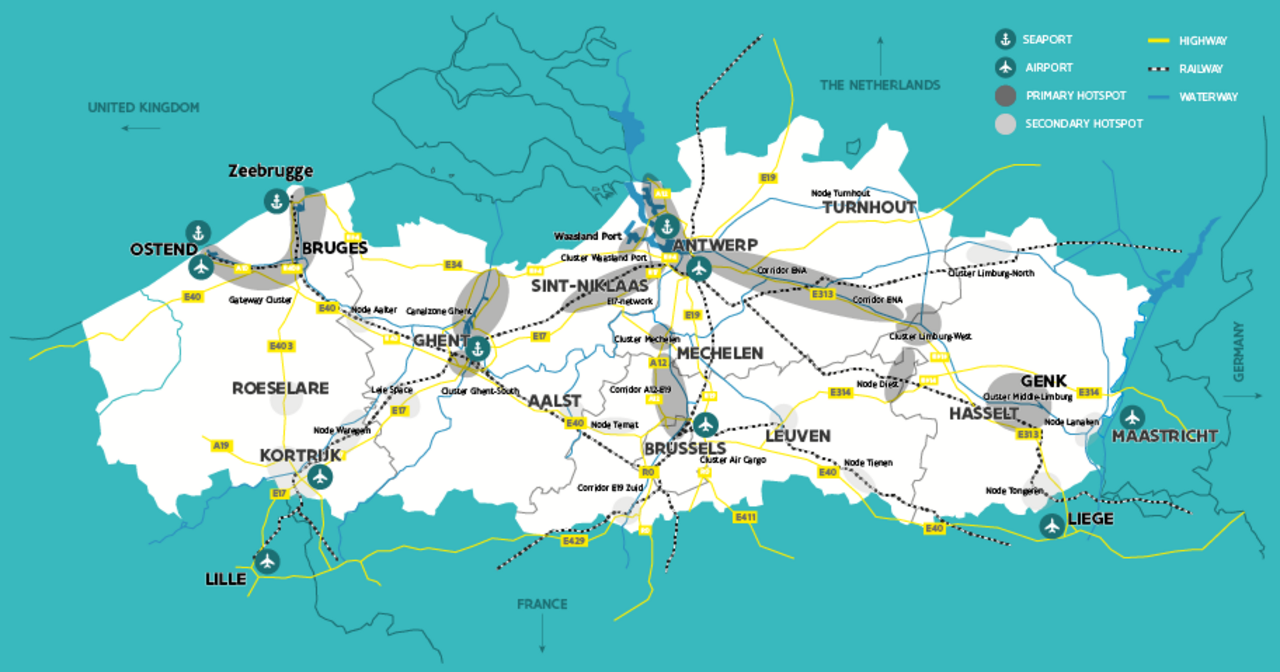How Flanders' infrastructure connects your business to the world
South of the Netherlands, west of Germany, north of France and just a hop away from the UK, Flanders is the perfect European hub for commerce. Through Flanders, multinational corporations have prime, rapid access to the rest of the European continent.
Flanders, the northern region of Belgium
Flanders is one of the three independently governed regions of Belgium, which consistently ranks as one the world’s most globalized economies according to the KOF Index of Globalization. The capital of both Belgium and Flanders is Brussels, home to NATO, the EU and other major public and private international decision-making centers.
60% of Europe’s purchasing power within 500 kilometers
The majority of Europe’s purchasing power is located within a 500-kilometer radius of Flanders. This means that Europe’s main markets can be reached in less than 24 hours.
Flanders is centrally located within this megalopolis – stretching from Greater London to the Netherlands, Belgium, and parts of Germany and France. As such, the region ensures smooth access to one of the world’s highest concentrations of people, money and industries.
To top it all off, Flanders is a great place for setting up logistics activities, essential to tap into this vast market potential. To put this into perspective: despite its small area of 13,522 km², Flanders has over 650 European distribution centers (EDCs) according to competitive analysis published by Flanders’ Mobility Department in 2017.
Dense network of ports, airports, roads, rail and waterways
Not only does Flanders boast 4 international seaports and 3 international airports, it also has the world’s densest road network and extremely well-connected railroad and inland waterway networks. The highways of Flanders link to those of France, Germany, the Netherlands, and those of the UK via ferry links or the Channel Tunnel. As a result, logistics companies and distribution centers are able to transport goods from Flanders to most major European markets within 24 hours by road.

Home to some of the world’s best ports
Flanders’ ports are among the best in the world. They score particularly high on accessibility and low on traffic congestion, with short lead times between the port and the customer.
Quality of port infrastructure - The Global Competitiveness Report, 2019
| Ranking | Country | Score |
|---|---|---|
| 1 | Singapore | 90.8 |
| 2 | Netherlands | 90.8 |
| 3 | Finland | 89.6 |
| 4 | Hong Kong | 87.9 |
| 5 | Japan | 80.1 |
| 6 | Denmark | 79.4 |
| 79 | Panama | 78.3 |
| 8 | Estonia | 76.1 |
| 9 | Belgium (Flanders) | 76.0 |
| 10 | USA | 75.9 |
Source: World Economic Forum, The Global Competitiveness Report, 2019
In short, this is why you should invest near a port of Flanders:
- ideal geographical location in the heart of western Europe,
- competitive, total supply chain cost and a complete logistical solution,
- excellent delivery of quality services.
Port of Antwerp-Bruges: pioneering a sustainable future
- Unified port resulting from the merger between the Port of Antwerp and the Port of Zeebrugge
- Home to Europe’s largest integrated petrochemical cluster (in Antwerp)
- A testing ground for green, digital and smart port innovations
- Consistently ranked as one of Europe’s largest ports based on TEU volumes
North Sea Port Ghent: biobased economy hub
- Located in the central eastern area of Flanders
- Focuses strongly on the production and logistics of biobased products
- One of the world’s largest fruit juice ports
- European leader in biofuel transport
Port of Ostend: major ro-ro port
- Specializes in handling roll-on/roll-off goods as well as sand and gravel for the construction industry
- Important hub for the construction and maintenance of offshore windfarms in the North Sea
- Offers excellent connections to Flanders’ motorways and railway network
Very dense road and railway network
- European number 7 for share of road transport (source: Eurostat, 2018)
- World’s 4th-densest railway network, covering an area of 13,700 km2 (source: 2019 Global Competitiveness Report)
- 1,700 kilometers of track
High-potential inland waterway network
- One of the world’s densest river and canal networks
- 1,375 kilometers of navigable waterways, 1,076 used for commercial navigation
- 16.1% of transport volumes concern inland waterway transport, ranking 4th in Europe (source: Eurostat, 2018)
- 80% of all companies in Flanders located fewer than 10 kilometers from a navigable waterway
Easily accessible through international airports
Being roughly the same size as the county of Yorkshire, Flanders is not only an easy place to travel around by car or public transport. The small region also boasts four international airports, easily connecting your business to the rest of the world in no time.